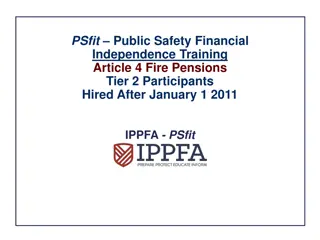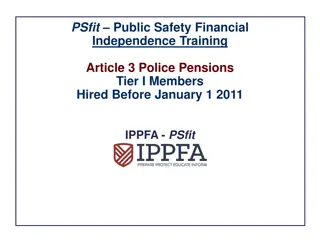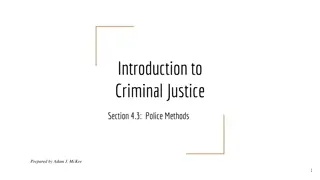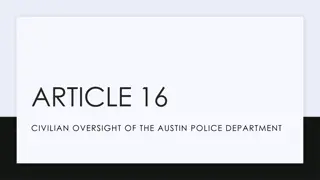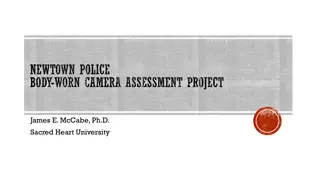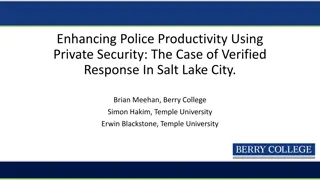Understanding Police Pensions for Tier 2 Members Hired After January 1, 2011
Explore the key aspects of police pensions for Tier 2 members hired after January 1, 2011, including the three legs of retirement, the definition of a pension, salary considerations, pension formulas, retirement age options, and pension increase details. Gain insights into the Illinois Article 3 pension system and how it impacts police officers' retirement benefits.
Download Presentation

Please find below an Image/Link to download the presentation.
The content on the website is provided AS IS for your information and personal use only. It may not be sold, licensed, or shared on other websites without obtaining consent from the author. Download presentation by click this link. If you encounter any issues during the download, it is possible that the publisher has removed the file from their server.
E N D
Presentation Transcript
PSfit Public Safety Financial Independence Training Article 3 Police Pensions Tier 2 Members Hired After January 1 2011 IPPFA - PSfit
The Three-Legs of Retirement For most workers, wages are replaced in retirement by the so-called three legs of the retirement stool: Pension, Social Security and personal savings. For many public employees, the main element of personal savings is a deferred compensation plan. So for core retirement training, our chapters are: Pension Social Security Deferred Compensation Retirement Planning 2
What is a Pension? A pension is a fixed monthly payment that replaces income that is lost due to: Age Disability Death (particularly pre-mature death) A pension benefit for retired police officers (outside of Chicago and small towns) is established under Article 3 of the Illinois Pension Code and referred to as the Downstate police pension system. 3
Article 3 Definition of Salary Defined Benefit pension systems pay a pension to a retiree based on his or her salary and length of service. As to salary for Illinois Article 3 police officers . For Tier 2 retirees, the average of the last eight years is used, excluding overtime. Also, the pension salary for Tier 2 retirees is capped at an amount set in the law, adjusted for inflation. In 2018, that amount is $113,645. 4
Pension Formula Tier 2 For persons attaining 10 years of service, the pension formulas are the same for Tier 1 and Tier 2. The formula is below 2.5% x years of service x salary (max: 75%). Example: 2.5% x 30 years x $75,000 = $4,688 per month (75% of a monthly salary of $6,250). Example: 2.5% x 15 years x $75,000 = $2,344 per month (37.5% of a monthly salary of $6,250). 5
Retirement Age Tier 2 The formula pension benefit is payable in full Age 55. However, Tier 2 employees can commence pension as early as age 50 but will incur a 6% decrease for each year pension is drawn before age 55. 6
Increases in Pension Tier 2 - If retired before age 60, at January 1st after attaining age 60, the Tier 2 pensioner receives an increase equal to of the increase in the CPI-U (inflation), but not more than 3%. Then, each January 1st thereafter, an additional increase equal to of the increase in the CPI-U x the original amount of pension (i.e. not compounded). - If retired on or after age 60, the same increases as described above begin on the January 1st after the pensioner has been retired for one year. 7
Disability Benefits For non-duty related conditions, benefits are 50% of salary. For duty-related conditions, benefits are 65% of salary or the pension earned by virtue of years of service (such as 70% of pay for 28 years of service). 8
Payments to Survivors Tier 2 - A spouse surviving a service or disability retiree receives 66-2/3% the monthly pension being paid. - A spouse surviving an active police officer who dies in the line-of-duty is entitled to 100% of pay. - A spouse surviving an active police officer who had 10 years of service and who dies not in the line-of-duty receives 66-2/3% of the pension he or she had earned. 9
Increases in Pension - Survivors Tier 2 Survivors. Surprisingly, unlike Tier 1 survivors, the law does include an annual increase for Tier 2 survivors in Article 3 Police Funds. The increase is the same as that for the pensioner of the CPI to a maximum of 3%, non-compounded, each January 1st. 10
Employee Contributions Tier 1 and Tier 2 members pay 9.91% of pensionable salary to the fund each payday. Contributions are often tax-exempt under a provision known as employer pick-up. It is not really payment by the employer, but is an allowable tax saving provision. Contributions are refundable or can be rolled-over to an IRA for employees who separate with less than 20 years of service. Contributions help fund the system and are an important part of the total pension financing plan. 11
Portability of Service Between Article 3 Funds The Pension Code allows an officer with at least two years of credited service to transfer or port his or her pension credit from one Article 3 community to another. The first fund makes a payment to the second fund in the amount of (a) the employee s payroll contributions, (b) an equal amount imputed to be the municipality s contribution and (c) 6% annual interest on both (a) and (b). If the dollar amount paid by the first fund is less than the true cost of the credited service earned at the first fund, either the officer must make up the difference or accept a reduced period of transferred service, prorated based on the amount of the true cost that the first fund paid to the second fund. 12
Portability: Example Jane had 3 years of service (36 months) at Eastown PD. Her payroll contributions were $14,000. She leaves there for Westown PD. To effect a portability transfer of service, Eastown pays Westown her $14,000, a match of $14,000 and $3,000 in interest, totaling $31,000. Westown s police fund actuary says the true cost of transferring 3 years of service is $38,750. Jane must make up the $7,750 difference or accept transfer of 29 months of credited service instead of 36 months. 13
Article 3 Police Funds Other Issues Governance: state law and local board two actives, a retiree and two citizens. The Illinois Division of Insurance acts as the regulator, including audits. Visit their website for information on your and other public pension funds. Member Data for Participation: help your pension plan keep track of marriages, divorces and children. Administrative Review your access to the court system if you disagree with a board decision. Other Players sponsor, actuary, lawyer, accountant and, possibly, an administrator company. 14
Questions ? Contact IPPFA!










